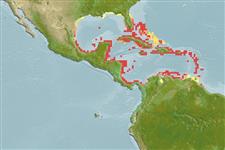Environment: milieu / climate zone / depth range / distribution range
Ekologi
laut berasosiasi dengan karang; nir-ruaya; kisaran kedalaman 0 - 3 m (Ref. 7247). Tropical; 32°N - 8°N, 98°W - 59°W
Western Central Atlantic: Florida, Gulf of Mexico, Caribbean Sea and along the coast of central America to Panama and Venezuela. Also known from the Bahamas and the Antilles.
Size / Weight / umur
Maturity: Lm ? range ? - ? cm
Max length : 15.0 cm TL jantan/; (Ref. 26340)
deskripsi pendek
Kunci identifiaksi (pengenalan) | Morfologi | Morfometrik
Duri punggung (Keseluruhan (total)) : 12; duri punggung lunak (Keseluruhan (total)) : 14 - 17; Duri dubur: 2; Sirip dubur lunak: 13 - 15. Juveniles are reddish orange above, with small bright blue spots on forehead and dark spots at upper pectoral fin base, dorsal fin, and caudal peduncle; colors disappear as fish grows larger (Ref. 26938). Adults dark gray to blackish with vertical black lines on body; a black spot, sometimes diffuse, at upper base of pectoral fins which are pale; other fins dark (Ref. 13442).
Adults inhabit rocky shores exposed to wave action. Often in tide pools. Feed primarily on algae and detritus. Territorial and pugnacious. Generally common (Ref. 9710). Oviparous, distinct pairing during breeding (Ref. 205). Eggs are demersal and adhere to the substrate (Ref. 205). Males guard and aerate the eggs (Ref. 205). Taken incidentally in traps and small-meshed beach nets (Ref. 5217).
Life cycle and mating behavior
Maturities | Reproduksi, perkembang biakan | Spawnings | Egg(s) | Fecundities | Larva
Oviparous, distinct pairing during breeding (Ref. 205). Eggs are demersal and adhere to the substrate (Ref. 205). Males guard and aerate the eggs (Ref. 205).
Allen, G.R., 1991. Damselfishes of the world. Mergus Publishers, Melle, Germany. 271 p. (Ref. 7247)
Status IUCN Red List (Ref. 130435)
ancaman kepada manusia
Harmless
penggunaan manusia
Perikanan: komersial; Akuarium: Komersial
Alat, peralatan
laporan khas
muat turun XML
Sumber internet
Estimates based on models
Preferred temperature (Ref.
123201): 26.2 - 28.3, mean 27.5 °C (based on 449 cells).
Phylogenetic diversity index (Ref.
82804): PD
50 = 0.5000 [Uniqueness, from 0.5 = low to 2.0 = high].
Bayesian length-weight: a=0.01950 (0.00893 - 0.04257), b=2.99 (2.81 - 3.17), in cm total length, based on LWR estimates for this Genus-body shape (Ref.
93245).
Trophic level (Ref.
69278): 2.5 ±0.1 se; based on diet studies.
Daya lenting (Ref.
120179): Tinggi, Waktu penggandaan populasi minimum kurang dari 15 bulan (Preliminary K or Fecundity.).
Fishing Vulnerability (Ref.
59153): Low vulnerability (10 of 100).
Nutrients (Ref.
124155): Calcium = 105 [52, 172] mg/100g; Iron = 0.724 [0.421, 1.239] mg/100g; Protein = 18.3 [17.1, 19.5] %; Omega3 = 0.0847 [, ] g/100g; Selenium = 16.2 [8.4, 32.9] μg/100g; VitaminA = 79.7 [20.8, 291.8] μg/100g; Zinc = 1.79 [1.18, 2.71] mg/100g (wet weight);
